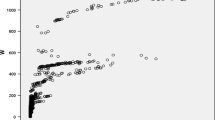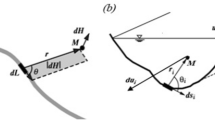Abstract
Determining the velocity profile of an open channel is essential in many hydraulic workspaces such as channel improvement studies, sediment modeling, and energy and turbidity calculations. Since the field observations are labor intensive and time-consuming, many empirical equations have been used for many years. Additionally, many data-based modeling studies have been conducted for both natural rivers and experimental channels. There are two objectives of this study. The first one consists of developing accurate models and criticizing the model performances based on the observational velocity dataset. Hence, classification and regression tree (C&RT), artificial neural network (ANN), and multilinear stepwise regression models are used with different input sets and the models are compared. The second objective is to gain a brief insight about the relationships of the velocity distribution model parameters and determining the significant variables for usage of further modeling studies by considering the co-linearity effects. The relative importance of input variables is investigated on settled models by using sensitivity analysis. The results of the sensitivity analysis indicated that for low-slope natural river studies, instead of using superfluous variables, using only four parameters (U sh , z/H, y/T and z/Y) is adequate to obtain accurate models. The predictive performances of C&RT model and the ANN model were found to be very close to each other, while the multilinear models appeared insufficient. The four variable input set is found superior to other input sets, and the variable water surface velocity is found the most significant parameter across all models.








Similar content being viewed by others
Abbreviations
- U m :
-
Mean velocity
- U sh :
-
Water surface velocity
- U :
-
Measured point flow velocity (target variable)
- H :
-
Water depth
- H max :
-
Maximum flow depth
- k s :
-
Equivalent sand roughness
- T :
-
Surface water width
- R :
-
Hydraulic radius
- Re :
-
Reynolds number of flows
- Fr :
-
Froude number of flows
- Q :
-
Discharge
- S :
-
Slope
- S ws :
-
Water surface slope
- u :
-
Point flow velocity at a specific longitudinal height
- u * :
-
Shear velocity
- y :
-
Lateral measured point distance from channel wall
- z :
-
Longitudinal distance of the measured point from channel bed
- ρ :
-
Density of the fluid
- υ :
-
Kinematic viscosity
- χ :
-
Von Karman constant
- τ 0 :
-
Shear stress
References
Araujo JC, Chaudhry FH (1996) Experimental evaluation of 2-D entropy model for open channel flow. J Hydraulic Eng 124(10):1064–1067
Kirkgoz MS, Ardiclioglu M (1997) Velocity profiles of developing and developed open channel flow. J Hydraulic Eng 123(12):1099–1105
Sill BL (1982) New flat plate turbulent velocity profiles. J Hydraulic Eng 108(1):1–15
Willis JC (1985) Near-bed velocity distribution. J Hydraulic Eng 111(5):741–753
Bahramifara A, Shirkhanib R, Mohammadic M (2013) An ANFIS-based approach for predicting the manning roughness coefficient in alluvial channels at the bank-full stage. IJE Trans B Appl 26(2):177–186
Ardıçlıoğlu M, Genç O, Kalin L, Ağıralioğlu N (2012) Investigation of flow properties in natural streams by entropy concept. Water Environ J 26:147–154
Samandar A (2011) A model of adaptive neural-based fuzzy inference system (ANFIS) for prediction of friction coefficient in open channel flow. Sci Res Essays 6(5):1020–1027
Snell J, Sivapalan M (1995) Application of the meta-channel concept: construction of the meta-channel hydraulic geometry for a natural catchment. Hydrol Process 9:485–505
Saco PM, Kumar P (2002) Kinematic dispersion in stream networks: 1 Coupling hydraulic and network geometry. Water Resour Res 38(11):1244
Paik K, Kumar P (2004) Hydraulic geometry and the nonlinearity of the network instantaneous response. Water Resour Res 40:W03602. doi:10.1029/2003WR002821
Paik K, Kumar P (2010) Optimality approaches to describe characteristic fluvial patterns on landscapes. Philos Trans R Soc B 365:1387–1395
Ozturk F, Apaydın H, Walling DE (2001) Suspended sediment loads through flood events for streams of sakarya Basin. Turkish J Eng Environ 25:643–650
Noor H, Fazli S, Alibakhshi SM (2013) Evaluation of the relationships between runoff-rainfall-sediment related nutrient loss (a case study: Kojour Watershed, Iran). Soil Water Res 8(4):172–177
Fulazzakya MA, Khamiduna MH, Yusof B (2013) Sediment traps from synthetic construction site stormwater runoff by grassed filter strip. J Hydrol 502:53–61
Hadadin N, Tarawneh Z, Shatanawi K, Banihani Q, Hamdi M (2013) Hydrological analysis for floodplain hazard of Jeddah’s drainage basin, Saudi Arabia. Arab J For Sci Eng 38(12):3275–3287
Mekanik F, Imteaz MA, Gato-Trinidad S, Elmahdi A (2013) Multiple regression and artificial neural network for long-term rainfall forecasting using large scale climate modes. J Hydrol 503:11–12
Davranche A, Poulinb B, Lefebvre G (2013) Mapping flooding regimes in Camargue wetlands using seasonal multispectral data. Remote Sens Environ 138:165–171
Razavi T, Coulibaly P (2013) Streamflow prediction in ungauged basins: review of regionalization methods. J Hydrol Eng 18(8):958–975
Li JZ, Feng P, Wei ZZ (2013) Incorporating the data of different watersheds to estimate the effects of land use change on flood peak and volume using multi-linear regression. Mitig Adapt Strat Glob Change 18(8):1183–1196
Bhattacharya B, Price RK, Solomatine DP (2007) Machine learning approach to modelling, sediment transport. J Hydraulic Eng ASCE 133(4):440–450
Oehler F, Coco G, Green MO, Bryan KR (2012) A data-driven approach to predict suspended-sediment reference concentration under non-breaking waves. Cont Shelf Res 46:96–106
Tchaban T, Taylor MJ, Griffin A (1998) Establishing impacts of the inputs in a feedforward network. Neural Comput Appl 7:309–317. doi:10.1007/BF01428122
Olden JD, Joy MK, Death RG (2004) An accurate comparison of methods for quantifying variable importance in artificial neural networks using simulated data. Ecol Model 178:389–397
Kemp JS, Zaradic P, Hansen F (2007) An approach for determining relative input parameter importance and significance in artificial neural networks. Ecol Model 204:326–334
Pektaş AO, Erdik T (2014) Peak discharge prediction due to embankment dam break by using sensitivity analysis based ANN. KSCE J Civil Eng 18:1868–1876
Duricic J, Erdik T, Pektaş AO, van Gelder PH (2013) Mean normalized force computation for different types of obstacles due to dam break using statistical techniques. Water 5:560–577
Murtaugh PA (2009) Performance of several variable-selection methods applied to real ecological data. Ecol Lett 12:1061–1068
Karman TV (1930). Meshanische Ahnlichkeit und Turbulenz. GöttingerNachrichten, Math, Phys, Klasse, pp 58–60, Germany
Prandtl L (1932) Recent results of turbulent research, translation by National Advisory Committee for Aeronautics, TM no. 720 (originally published in German in 1933)
Song T, Graf WH (1996) Velocity and turbulence distribution in unsteady open channel flows. J Hydraulic Eng 122(3):141–154
Kundu S, Ghoshal K (2012) Velocity distribution in open channels: combination of log-law and parabolic-law. World Acad Sci Eng Technol 68:2012
Chanson H (2004) The hydraulics of open channel flow: an introduction, 2nd ed. Elsevier Butterworth-Heinemann, Oxford, xlvii, p 585
Montes S (1998) Hydraulics of open channel flow. ASCE Press, Reston, VA, viii, p 697
Genc O (2012) The investigation of flow properties in rivers by entropy method. Ph.D. Thesis, accepted in October 2012, Istanbul Technical University
Buckingham E (1914) On physically similar systems: illustrations of the use of dimensional equations. Phys Rev 4(4):345–376
SPSS Modeller 15 (2012) IBM SPSS Modeller 15 Algorithms, Guide, Copyright IBM Corporation 1994, 2012
IBM SPSS Decision Trees 20 (2011) Copyright SPSS Inc. 1989, 2011
Acknowledgments
The author would like to thank Dr. Onur Genc for his assistance in providing the observational data set. The data are depicted from the Ph.D. Thesis of Onur Genc which was completed under the supervision of Prof. Dr. Necati Ağıralioğlu. The Thesis was accepted in October 2012 at Istanbul Technical University.
Conflict of interest
The author declares no conflict of interest.
Author information
Authors and Affiliations
Corresponding author
Rights and permissions
About this article
Cite this article
Pektas, A.O. Computational modeling with sensitivity analysis: case study velocity distribution of natural rivers. Neural Comput & Applic 26, 1653–1667 (2015). https://doi.org/10.1007/s00521-015-1830-2
Received:
Accepted:
Published:
Issue Date:
DOI: https://doi.org/10.1007/s00521-015-1830-2




